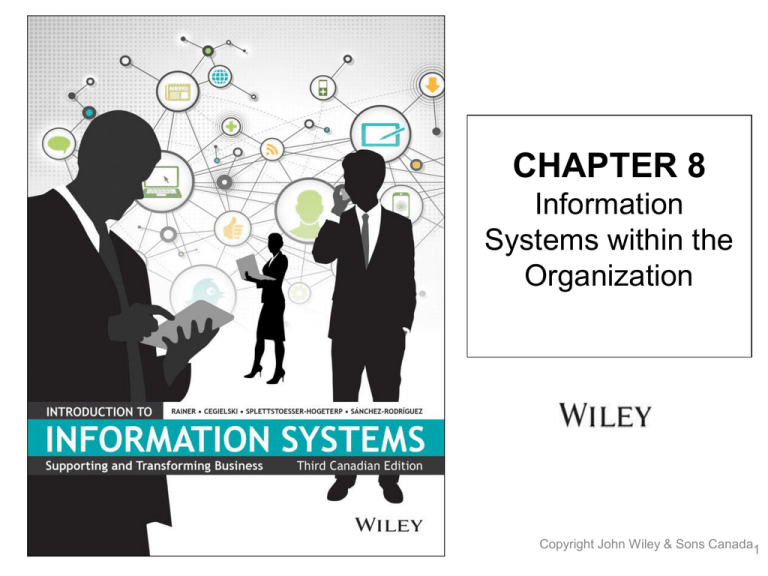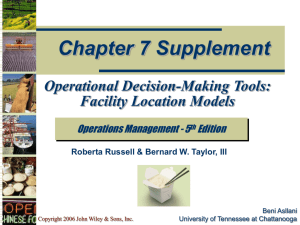
CHAPTER 8
Information
Systems within the
Organization
Copyright John Wiley & Sons Canada1
Chapter 8:
Information Systems within the
Organization
8.1 Transaction Processing Systems
8.2 Functional Area Information Systems
8.3 Enterprise Resource Planning Systems
8.4 Reports
Copyright John Wiley & Sons Canada
2
LEARNING OBJECTIVES
1. Explain the purposes of transaction processing
systems. Provide at least one example of how
businesses use these systems.
2. Define functional area information systems. Provide an
example of the support they provide for each functional
area of the organization.
Copyright John Wiley & Sons Canada
3
LEARNING OBJECTIVES
(CONTINUED)
3. Explain the purpose of enterprise resource planning
systems. Identify four advantages and four drawbacks
to implementing an ERP system.
4. Discuss the three major types of reports generated by
the functional area information systems and enterprise
resource planning systems. Provide an example of
each type.
Copyright John Wiley & Sons Canada
4
8.1 OPENING CASE: IS BASEBALL
A SCIENCE?
The Problem
– John Dewan, the owner of Baseball Info Solutions (BIS;
www2.baseballinfosolutions.com), has made collecting data on
fielding statistics his latest mission. The BIS data, however, are
not perfect. For example, they do not indicate where a fielder
was standing when the ball was hit. In addition, the data are
susceptible to human error, and could be off by 15 to 20 feet (4.5
to 6 m) on some plays. Dewan estimated that BIS and its video
scouts could measure only 60 percent of a fielder’s ability.
Copyright John Wiley & Sons Canada
5
8.1 OPENING CASE: IS BASEBALL
A SCIENCE?
•
The Solution
– Sportvision created Fieldf/x, a motion-capture, or optical tracking
system that helps eliminate human error and the need to be in
the right place at the right time. Fieldf/x uses four cameras
placed high above the field to track players and the ball, and to
log their movements. The system generates more than 2.5
million records per game, or 2 terabytes of data.
Copyright John Wiley & Sons Canada
6
8.1 OPENING CASE: IS BASEBALL
A SCIENCE?
•
The Results
– Ultimately, Fieldf/x will generate new baseball metrics, such as
degree-of-difficulty fielding ratings. Fieldf/x also will make
coaching more precise; for example, coaches will be able to
better position their fielders, depending on the hitter and the
pitch being thrown (e.g., fast ball versus slow curve ball). Finally,
the system will enhance the process by which clubs evaluate—
and pay—their players.
Copyright John Wiley & Sons Canada
7
8.1 OPENING CASE: IS BASEBALL
A SCIENCE?
•
Discussion
– What is the major attribute of Fieldf/x?
– What was the significant difference between the 2 systems that
mitigated human error?
Copyright John Wiley & Sons Canada
8
8.1 IT’S ABOUT [SMALL AND BIG]
BUSINESS
•
Pizza Pizza’s Customer App
–
–
–
–
–
–
created an iPhone app for ordering customized pizza
app is free and fun
won several design awards
brings in more sales
convenient for customers
reduces costs and saves the potential for error
Copyright John Wiley & Sons Canada
9
8.1 TRANSACTION PROCESSING
SYSTEMS (TPS)
•
•
Grocery store clerks use a bar code scanner that
produces data captured by a transaction processing
system
The TPS collects data continuously, in real time, as
soon as the data are generated, and it provides the
input data for the corporate databases.
Copyright John Wiley & Sons Canada
10
FIGURE 8.1 HOW TPS MANAGE
DATA
Copyright John Wiley & Sons Canada
11
8.2 FUNCTIONAL AREA
INFORMATION SYSTEMS
•
Functional Area Information Systems (FAIS) provide
support for the various functional areas (below) in an
organization by increasing each area’s internal
efficiency and effectiveness
–
–
–
–
–
Accounting
Finance
Marketing
Operations (POM)
Human Resources Management
Copyright John Wiley & Sons Canada
12
INFORMATION SYSTEMS FOR
ACCOUNTING AND FINANCE
•
Financial Planning and Budgeting
– Financial and economic forecasting
– Planning and Budgeting
•
Managing Financial Transactions
–
–
–
–
Global stock exchanges
Multiple currency management
Virtual close
Expense management automation
Copyright John Wiley & Sons Canada
13
INFORMATION SYSTEMS FOR
ACCOUNTING AND FINANCE
(CONTINUED)
•
•
Investment Management
Control and Auditing
– Budgetary control
– Internal auditing
– Financial ratio analysis
Copyright John Wiley & Sons Canada
14
INFORMATION SYSTEMS FOR
MARKETING
•
•
•
Customer relations
Customer profiles and preferences
Sales force automation
Copyright John Wiley & Sons Canada
15
INFORMATION SYSTEMS FOR
PRODUCTION AND OPERATIONS
MANAGEMENT
•
In-House Logistics and Materials Management
– Inventory Management
– Quality Control
•
•
•
Planning Production and Operations
Computer-Integrated Manufacturing
Product Life Cycle Management
Copyright John Wiley & Sons Canada
16
INFORMATION SYSTEMS FOR
HUMAN RESOURCES
•
•
•
Recruitment
HR Maintenance and Development
HR Planning and Management
– Payroll and employees’ records
– Benefits administration
– Employee relationship management
Copyright John Wiley & Sons Canada
17
FIGURE 8.2 EXAMPLES OF
INFORMATION SYSTEMS SUPPORTING
THE FUNCTIONAL AREAS
Copyright John Wiley & Sons Canada
18
8.3 ENTERPRISE RESOURCE
PLANNING SYSTEMS (ERP)
•
Enterprise Resource Planning (ERP) system adopts a
business process view of the overall organization to
integrate the planning, management, and use of all of
an organization’s resources, employing a common
software platform and database.
Copyright John Wiley & Sons Canada
19
ERP SOFTWARE VENDORS
•
Most organizations use commercially available ERP
software from major vendors including:
– SAP
– Oracle
– PeopleSoft
•
Click here for up-to-date information on ERP software
Copyright John Wiley & Sons Canada
20
8.2 IT’S ABOUT BUSINESS
•
Airgas switched over its hard-goods supply chain
operation to SAP in July 2010:
– affects nearly every area of Airgas
– 70 percent of its information systems functional on SAP as of
March 2013
– expected to have saved up to $125 million by the end of 2013
– improved sales, better price management, and leaner operating
costs
Copyright John Wiley & Sons Canada
21
ERP II SYSTEMS
Copyright John Wiley & Sons Canada
22
ERP MODULES
•
Core ERP Modules
• Extended ERP Modules
– Financial Management
– Operations Management
– Human resource management
Copyright John Wiley & Sons Canada
– Customer relationship
management
– Supply Chain
Management
– Business intelligence
– E-business
23
BENEFITS OF ERP SYSTEMS
•
•
•
Organizational flexibility and agility
Decision support
Quality and efficiency
Copyright John Wiley & Sons Canada
24
LIMITATIONS OF ERP SYSTEMS
•
•
•
Companies may need to change existing business
processes to fit the predefined business processes of
the software (best practices)
Complex, expensive, and time consuming to implement
Underestimating the complexity of the planning,
development, and training required to prepare for a new
ERP system
Copyright John Wiley & Sons Canada
25
8.4 REPORTS
•
•
Routine reports are produced at scheduled intervals
(hourly quality control report, daily reports on
absenteeism rates)
Non-routine or Ad hoc (on demand) reports:
–
–
–
•
Drill-down reports
Key-indicator reports
Comparative reports
Exception reports include only information that falls
outside certain threshold standards
Copyright John Wiley & Sons Canada
26
TYPES OF REPORTS
•
•
•
•
•
•
Summary Report
Detailed report
Drill-down report
Key-indicator report
Comparative report
Exception Report
Copyright John Wiley & Sons Canada
27
CHAPTER CLOSING
•
•
•
•
TPSs monitor, store, collect, and process data
generated from all business transactions.
Major business functional areas are
production/operations management, marketing,
accounting/finance, and human resources
management.
Enterprise resource planning (ERP) systems integrate
the planning, management, and use of all of the
organization’s resources.
Three major types of reports generated by FAIS and
ERP systems are: Routine, Nonroutine or ad hoc (ondemand) and Exception.
Copyright John Wiley & Sons Canada
28
Copyright
Copyright © 2014 John Wiley & Sons Canada, Ltd. All rights
reserved. Reproduction or translation of this work beyond
that permitted by Access Copyright (the Canadian copyright
licensing agency) is unlawful. Requests for further
information should be addressed to the Permissions
Department, John Wiley & Sons Canada, Ltd. The purchaser
may make back-up copies for his or her own use only and
not for distribution or resale. The author and the publisher
assume no responsibility for errors, omissions, or damages
caused by the use of these files or programs or from the use
of the information contained herein.






